Pedometers are devices used to track the number of steps you take in a day. Modern pedometers are multifaceted and include a variety of health indicators in addition to monitoring your distance.
Most pedometers can track hourly activity levels, sleep score, calories burned as well as resting and active heart rates. Bellow, you’ll find the top 10 pedometers recommended by our team of in-depth health experts, as well as their benefits and uses.
Rankings
1. Fitbit Inspire

Fitbit’s Inspire connects to smartphones via Bluetooth to track steps, distance, and activity data. It works around-the-clock to accurately track sleep habits and other key statistics, allowing wearers to get a clearer picture of their health.
The Fitbit Inspire also automatically detects what type of activity you are doing and tracks it accordingly. For these reasons, it’s our #1 pick.
2. Fitbit Versa 2
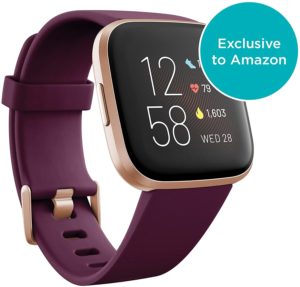
Fitbit’s Versa 2 model has almost as many features as a smartwatch. It’s compatible with Amazon Alexa, and syncs music from Pandora and other streaming services.
This pedometer also has a color screen and syncs with smartphones up to 6.1 meters away. When sleep tracking is enabled, this machine offers a detailed analysis of sleep cycles, including REM sleep patterns.
3. Garmin Vivosmart 4
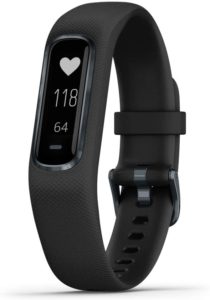
Garmin’s Vivosmart 4 is sleek, water-resistant and full of smartphone-compatible features. Despite its small screen, it can display a wide range of information on demand for various activities, including walking, running, yoga, and and swimming.
The battery lasts for up to 7 days, reducing the need to remove and charge it.
4. Garmin Instinct

The tough and reliable Garmin Instinct is shock and thermal-resistant up to U.S. military standards, and water-resistant up to 100 meters. It has built-in GPS, as well as all the usual smartphone-compatible activity tracking features and apps.
This pedometer is larger than many similar models, so the screen is easy to read from farther away.
5. Fitbit Alta HR
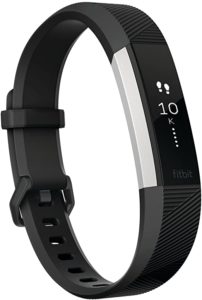
Fitbit’s Alta HR has many of the same features of the Inspire and Versa 2, but it’s not fully water-resistant. This pedometer has a 7-day battery life and tracks activity and heart rate at all times.
It also helps users optimize their workout habits by tracking cardio warmup and cooldown.
6. Garmin Vivoactive 3

Garmin’s Vivoactive 3 has a large screen like their Instinct model, but a sleek design similar to the Vivoactive 4. While it’s a slightly older model but is still popular due to its numerous features and built-in GPS.
It also has excellent sports apps for activity tracking and is compatible with contactless payment methods.
7. Fitpolo Fitness Tracker Watch
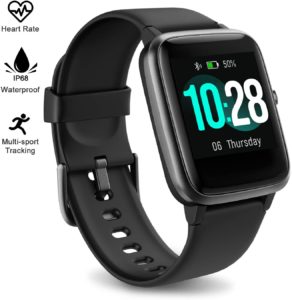
For budget-conscious buyers, the Fitpolo Fitness Tracker is a good investment. It has advanced pedometer functions and 8 sport modes, plus many smartphone syncing features like call and text notifications.
Its large square screen is easy to use and displays information clearly in color. The battery also lasts up to 10 days with moderate usage.
8. Lintelek Fitness Tracker
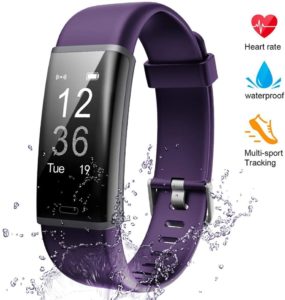
Lintelek ‘s Fitness Tracker is a budget-friendly pedometer that packs a lot of features into its small screen. It has 14 exercise modes to accurately track activities, plus a standard all-day step counter and sleep monitor.
Although it’s not fully waterproof, it can be worn in the rain and while washing hands.
9. Garmin Forerunner 645

The running-focused Garmin Forerunner 645 watch has a wrist-based heart monitor for easy heart rate tracking. Its analytics focus on running stride length, vertical ratio, and other statistics for serious athletes.
The upgraded version of this model can store up to 500 downloaded songs, but the base model still works with smartphone music apps.
10. Fitbit Charge 3
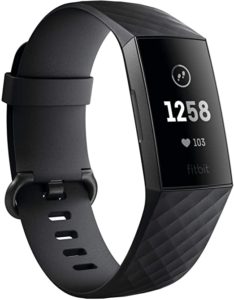
Like other Fitbit models featured here, the Fitbit Charge 3 is accurate and easy to use. It has excellent social features and syncs quickly with smartphones.
Its screen isn’t as easy to read as some other models and it doesn’t have built-in GPS. However, it is water-resistant to 50 meters.
How We Ranked
The best pedometers focus on providing accurate and reliable measurements for daily movements, walking, and running. Pedometers such as the Fitbit Inspire and Garmin’s Vivoactive connect with GPS and heart rate monitoring to give the most accurate measurements for an athlete’s workout steps.
For our rankings, we also accounted for the number of useful health and fitness features like GPS and heart rate monitoring. Music syncing, call notifications, and other extras were factored into rankings. The Garmin Forerunner 645’s additional features, such as music storage of up to 500 songs and stride length, made this customizable pedometer a great choice for recreational and serious athletes.
Water-resistance is an important feature, especially for individuals who swim competitively or spend a lot of time in the water. The Fitbit Charge 3 provided water-resistance up to 50 meters is a crucial feature that ranked it in our top ten.
Price was the final factor that allowed for some budget brands to be included, as they offered excellent value. Garmin and Fitbit both have fantastic, affordable options for exercise enthusiasts on a budget. Both brands take most of the top spots on our list, although Fitbit remains more popular because they are less expensive on average. Fitpolo and Lintelek are lesser-known brands that still perform well. They have become popular in recent years, in part due to their lower price point. Although they do not have as many advanced features as Fitbit and Garmin, they are good for people who just need basic exercise and fitness data or who do not plan on wearing them every day.
Benefits
Pedometers may help you experience the immediate benefits of increased activity. Pedometers can help motivate individuals to increase their activity levels. Increased activity has been linked to short-term benefits, such as better focus and cognition, higher self-esteem, lower short-term anxiety, improved sleep, and reduced risk for depression and anxiety (1).
Pedometers may help you experience the mid- and long-term benefits of increased activity. Since pedometers motivate and encourage activity, they can be instrumental tools in your healthcare journey – helping you to live a longer, healthier, and happier life. Increased activity can help you lose excess weight, gain healthy muscle mass, and maintain a healthy weight (2).
It also protect against a number of diseases, such as cancer, depression, anxiety, cardiovascular disease, diabetes, and sleep disorders (3). Increased activity levels have also been linked to increased longevity, improved muscle mass, increased bone mass, and a decreased risk of injury (4).
Pedometers provide motivational and social benefits. With both phone and watchband notifications at set intervals of the day, these reminders help you remember that you need to get up and stretch or take a walk to meet your daily step goals. Additionally, pedometer apps allow you to integrate into fitness challenges with friends, family, and coworkers. Competitions are a great way to stay motivated and promote a healthier lifestyle.
You can upload your daily steps to a group challenge and earn points for yourself or your team. These kinds of competitions provide significant social benefits, as they encourage discussion of goals, coordination of workouts, and sometimes bragging rights.
Pedometers may help improve the outcome of chronic disease patients. Pedometers give feedback to these patients and to their doctors to help promote increased activity levels and set daily, weekly, or monthly fitness goals. In conjunction with standard treatment approaches, using a pedometer to increase physical activity may help improve the symptoms and health outcomes for patients suffering from chronic diseases, such as dementia, ADHD, stroke, schizophrenia, and Parkinson’s disease (5).
For patients with a spinal cord injury or multiple sclerosis, increased activity levels can improve muscular strength, walking speed and function, upper extremity function, endurance, and cognition. In cancer survivors, physical activity can help improve health-related quality of life, mental and emotional well-being, and physical fitness after cancer. In addition, regular, physician-recommended levels of activity can help those with osteoarthritis experience decreased pain, improved quality of life, and more physical function.
For individuals with hypertension, physical activity can prevent increased blood pressure over time, reduce cardiovascular disease progression, and lower cardiovascular disease mortality risk. Type 2 diabetes patients find that increased activity levels can reduce the progression of disease indicators and lower mortality risk.
Pedometers help physicians monitor patient activity and prescribe personalized activity levels. No person is built the same, and activity is most effective when monitored and approved by a healthcare professional. Smart pedometers and activity trackers enable physicians to motivate their patients and give their patients both qualitative and quantitative goals. Physicians can use smart pedometers to easily prescribe recommended activities, length of activities, heart rate, intensity, and frequency to excellent effect (6).
This mode of activity prescription works exceptionally well due to pedometers’ ability to motivate patients with gentle reminders to get moving, track their activity, provide external accountability, and facilitate realistic goal setting.
Pedometers catch small, incremental changes in daily routine. A pedometer can help you identify, track, and monitor incremental changes in levels of incidental activity. These small details add up over time, and high levels of incidental movement are associated with an increased lifespan and improved cognition as individuals age (7).
Pedometers can help you make mental and emotional health gains. Pedometers help to motivate physical activity, which has been shown to improve mental and emotional well-being (8). Increased blood flow to the brain, coupled with influence on the HPA (hypothalamic-pituitary-adrenal) axis changes how the body responds to stress, reducing either the risks or the symptomatology of depression and anxiety.
Because exercise influences the HPA axis, it also boosts limbic system health, which controls emotion and mood. Increased exercise using a pedometer also improves hippocampus activity, which plays a critical role in mood, motivation, and memory formation, and amygdala response, which controls fear.
These neurological benefits of exercise extend to encourage interest in sex, improve everyday mood, and increase alertness and focus. The results are improved overall cognitive function, increased self-esteem, improved social interaction, and a reduction in symptoms related to anxiety, depression, or schizophrenia (9).
Pedometers and exercise may aid individuals recovering from Substance Use Disorder. According to one 2014 study, exercise can help ease withdrawal symptoms, anxiety, and depression in individuals with Substance Use Disorder (SUD) (10).
However, more evidence is needed to determine to what extent exercise may mitigate depression symptoms in SUD patients with an alcohol or nicotine dependence.
Some pedometers can provide in-depth sleep data for individuals suffering from sleep disorders. Some advanced pedometers and smart watches use heart rate and activity data to calculate time spent in light sleep, deep sleep, and REM sleep. Healthcare professionals can use this data to improve or address patients’ overall sleep quality.
Side Effects
Pedometers may be unsuitable for individuals with exercise addiction. While pedometers are generally regarded as safe and effective tools for monitoring health behaviors, they have technical limitations and may be unsuitable for individuals with certain mental health conditions or psychological predispositions.
Whereas regular exercise promotes both psychological and physical well-being, compulsive exercise can lead to overtraining and overuse injuries. Negative exercise addiction can also cause social isolation and physical and psychological instability. Symptoms of overuse can include a decrease in physical performance, reduced immunity, chronic musculoskeletal deformation, exacerbated inflammatory responses, and chronic or acute pain (11).
Individuals who are addicted to exercise may find that pedometers stoke obsessive behavior or lead to increased preoccupation with their activity levels or their diet.
Certain smart pedometers may not accurately monitor heart rate in individuals with darker skin tones. Many smart pedometers use a specific technology that measures heart rate with light waves. Melanin absorbs the light wavelength, meaning that individuals with darker skin may not get an accurate reading on their heart rate data.
For individuals with a heart condition, this may be problematic for providing accurate health data (12).
Pedometers may pose challenges for individuals with an eating disorder. Eating disorders are characterized by disturbed eating habits, a disordered relationship with one’s body, and troubling thoughts or emotions surrounding food, weight, or exercise. From this perspective, eating habits and exercise habits become compulsive and motivated by external numbers (calories, steps, weight, or size).
This relationship with movement can be exacerbated by the presence of a pedometer. An individual who has an eating disorder may lose bone mass, muscle mass, suffer from weakened immunity, or struggle with symptoms of overtraining that leave them more prone to illness and injury.
Pedometers may discourage activity when they’re not being worn. If an individual becomes accustomed to an external reward system that tracks steps and calories burned, they might find themselves demotivated to move if they are separated from the device.
In other words, they can encourage a mindset that “it doesn’t count unless it’s counted,” which may have negative effects on their attitude to daily exercise.
Advanced or overly technical features may turn seniors off to using a pedometer. Much like advancements in smartphone technology, pedometers that are overly complicated or too technologically advanced may put them out of reach for seniors who could benefit significantly from pedometer use, such as elders with rheumatoid arthritis.
Setting up the pedometer to measure stride length, vertical ratio, and other features takes time and technological know-how. Furthermore, since many pedometers sync with Bluetooth, older individuals or individuals without smartphones won’t be able to use many modern fitness trackers.
A pedometer can drain phone battery life and use up data. Whenever you sync a new device to your phone, you are allowing the two to communicate digitally. This means that your phone must work to send and receive data and send notifications, which can drain the battery life on your phone faster.
If you have a limited data plan, that communication can also use up data. While most digital pedometers push out automatic updates to address high battery drain and data usage, you may also have to manually check for updates to the app in your phone’s app store.
Recommended Usage
A pedometer should be worn throughout the day to track your movements. It can also be worn during sleep to tracks, REM and other sleep patterns.
Given the proliferation of smart pedometers and health habit tracking devices, you may need to download an app or link your phone with the device.
FAQ
How does a pedometer work? Pedometers measure strides by analyzing the side to side swing of your body as you walk. Each swing counts as a single step in the machine’s algorithm.
Is your phone considered a pedometer? While not the most accurate, your phone can be used as a pedometer. However, there tends to be more data inconsistencies because of the amount the phone moves during the day.
Where is the best place to wear a pedometer? The best place to wear a pedometer is on the side, above your hip. It can also be worn just about the knee cap. These places allow for the most accurate tracking in terms of counting steps.
How often do pedometer apps track data? Most apps record your daily, weekly and even monthly steps, so you can study the data to track trends. You can also track your sleep patterns and resting and active heart rate, and how this data impacts your daily life. Some apps enable you to compare this data with others in your sex and age bracket.
Why do I need a pedometer? Pedometers can provide valuable information on health metrics. While they may be unsuitable for individuals who struggle with compulsive exercise or an eating disorder, smart pedometers provide the vast majority of the population with a functional, effective way to track activity, set goals, monitor heart rate, and take pride in their well-being advancements over time. They also allow patients to share valuable health data with their physicians and other healthcare professionals.
What should my daily goal on my pedometer be? Your daily activity goal is dependent upon your current health. Injuries, illness, or other pre-existing health conditions may determine a reasonable goal for your unique needs.
If you are unsure about where to start, consult with your healthcare practitioner for more detailed advice on goal setting with a pedometer. For the average individual in good health, the CDC and the American Heart Association recommend 10,000 steps a day as a reasonable goal.
How many miles do you need to walk to hit 10,000 steps while wearing a pedometer? Ten thousand steps is approximately 5 miles. Although, not all steps are created equal. Height, stride length, terrain, clothing, and shoe choice all impact the relationship between the number of steps and number of miles.
It’s important to remember that walking up steep, varied terrain is more difficult and intense exercise than walking the same distance on flat, even terrain.
Do pedometer calories count towards burned calories? Yes, calories tracked in a pedometer count towards your daily caloric expenditure.
Can pedometers help you lose weight? Pedometers may help you lose weight by encouraging and rewarding movement. Just half an hour of semi-brisk walking can burn up to 200 calories per day, which can easily translate into fat loss.
How quickly should I increase my step count if I’m healthy, but I’m not at 10,000 steps per day? The American Heart Association and Centers for Disease Control and Prevention recommend that individuals increase their step count by 10-20% each week to work up to 10,000 steps.
This gives your body time to adjust and also allows you to more easily account for any adjustments in your weekly schedule. With many fitness apps, you can schedule this gradual increase in step goals, and your pedometer will alert you throughout the day as you near your target.
How can I help myself reach my step goal with my pedometer? Comfortable shoes, socks, and clothing are important first steps for motivating yourself to get up and move. When you arrive at work, park further away from the building to add a walk to your daily commute. You can also take the stairs instead of using the elevator or walk to a colleague’s office instead of calling or emailing them.
By adding social and exploration elements, such as new parks, trails, or gardens to your health pursuits, you’ll have fun while exercising and likely won’t even notice the steps you are adding to your daily step count.
You can also use your pedometer to engage in office, family, or friend-inspired fitness competitions. Most pedometers include challenges you can do alone or participate in with your friends and family. Relying on others to help boost your motivation to reach your step goals is a powerful tool.
What activities, other than walking or running, give me the most steps on my pedometer? Most team sports such as basketball, football, rugby, and soccer can help you achieve your daily fitness step goals. If you enjoy the outdoors, take a hike, do some rock climbing, track birds for bird watching or try some geocaching.
Group activities on the beach, such as volleyball and ultimate frisbee also net many steps. If you golf, you can also get plenty of steps in on the course.
Can you wear a pedometer on your shoe? While it is possible to attach your pedometer to your shoe, it may not be the best place in terms of tracking and safety. It may also fall off easier if your shoelace comes untied.
Can you wear a pedometer on your ankle? Yes, accelerometer-based pedometers can be worn on your ankle for accurate tracking.
How can pedometers help improve your fitness? Pedometers help improve fitness by providing useful data that can be used to tailor and exercise and diet program. It also helps with motivation by tracking goals and providing rewards for hitting those rewards. Studies even show that people who set goals with a pedometer are more likely to lose weight, lower blood pressure, and increase overall activity levels.
Can smart pedometers track weightlifting, yoga, or swimming? The smart pedometers on our list offer a wide variety of activity tracking capabilities. For instance, the Fitbit Inspire, our top choice, can track a variety of activities beyond simply running or walking. It tracks weights, yoga, and swimming, along with other activities such as kickboxing and martial arts.
How do I calculate my stride length on my pedometer? If your pedometer asks you to calculate your stride length, walk a known distance while counting your steps. Then, divide the distance by the number of steps taken to calculate your stride length.
A lot of newer smart pedometers can automatically calculate your stride length, so you may not have to manually do this.
How many steps does it take to walk one mile on a pedometer? It takes the average individual 2,000 steps to walk one mile, but this depends on your stride.
How many steps do I need to take per day on my pedometer to lose weight? Weight loss is determined by a number of factors and can mean multiple things. In a severe calorie deficit, weight loss can mean the loss of muscle mass and healthy water retention, as well as the loss of fat. In addition, the body’s predisposition to fat loss is determined by a variety of environmental, social, and genetic factors (13).
Sleep, stress levels, diet, and exercise all play a role in fat loss (14). As a result, there is no prescribed number of steps that equals weight loss for everyone.
What are some easy ways to increase the number of steps on my pedometer? Often referred to as incidental movement, gradual increases in non-exercise movement can have a tremendous overall impact on your health. You can increase your number of steps by completing simple tasks such as cleaning your home or walking as you talk on the phone.
Other incidental movement improvements you can make may take more thought, such as using a treadmill while you binge-watch your favorite TV show, or hosting walking meetings at work instead of in the conference room. Simple changes such as parking farther away from the door to a store or offering to take care of an elderly family member’s yard are also beneficial and easy to implement into your routine.
Is a multi-functional pedometer better than a simple pedometer? A modern, multi-functional pedometer can provide a plethora of healthcare data that enables you to take charge of your health. For most people, this is worth the few extra dollars.
Can I use my pedometer to track sleep? Some of the pedometers on this list, such as the Fitbit Inspire and the Lintelek Fitness Tracker, record how many hours you sleep. Once you’ve set the device to sleep mode, it will start recording sleep time if you haven’t moved for 30 minutes. It won’t stop counting sleep time if you move a little in your sleep, but once the device picks up substantial morning movement, it will assume you are awake.
Some advanced pedometers can document light sleep, deep sleep, and restless sleep. Others can also track sleep phases by analyzing heart rate and movement.
Which pedometer is best for outdoor pursuits and adventure sports? A pedometer with GPS mapping capabilities is ideal for trackingpursuits and adventure sports. The Garmin Instinct (found on our list) boasts a built-in GPS that can help runners, mountaineers, mountain bikers, and back-country snow enthusiasts track their adventures.
How long do pedometer batteries last? Many of the listed devices boast a battery life between 2-5 days, depending on how many functions are used. For example, the Garmin Instinct’s battery can last up to a week if the GPS function is not in use, or for two days if the GPS is used in conjunction with long, intense runs.
How can my doctor use information from my pedometer? Your doctor can use pedometer information to monitor your heart rate, sleep patterns, and chronic disease risk. If you’re interested in increasing your activity levels in a safe and controlled manner, your doctor can use your pedometer date to prescribe appropriate increases in activity over a period of time.
For individuals who struggle with insomnia, smart pedometers may be useful for tracking sleep data in conjunction with lifestyle and sleep hygiene changes. This can help you and your healthcare provider determine what changes are helpful for your sleep routine.
Can pedometers track my period? Smart pedometers that are compatible with Google Fit, Fitbit, and Apple Health apps can all be used to help track the female menstrual cycle. This function can help you understand patterns and trends in your cycle, as well as how physical activity affects your reproductive health. Healthcare providers can use this data to understand any problems with your cycle or with fertility should they arise.
How many calories does a pedometer help burn while walking? When walking, the average person will burn between 30-50 calories for every 1000 steps taken
What is the average pedometer steps per day? The average American logs around 6000 steps per day. The ideal minimum is 10000 steps to improve overall health.
Does a pedometer track accurately if used in your pocket? Ideally, you would wear the pedometer around your wrist or ankle, as these places have been shown to provide the most accurate data. When placed in a pocket, data can get skewed by the unbalanced environment of the pocket.
Are cheaper pedometers accurate? In general, cheaper pedometers provide similar accuracy to more expensive pedometers. Where they differ is the other health data that is tracked. Most cheaper pedometers are also not waterproof, making them less ideal if you are running in the rain.
Related Articles
Recap
Pedometers are multi-functional tools that offer users insight into their daily activity levels and can provide data on sleep habits, resting heart rate, calories consumed, and your menstrual cycle. Seasoned athletes and individuals struggling with chronic health conditions can use pedometers to assist their physician and coach to improve their well-being and performance.
For most people, a pedometer is a useful tool to monitor their daily activity and motivates them to achieve their health goals.
For FitBug’s #1 recommended pedometer, click here.